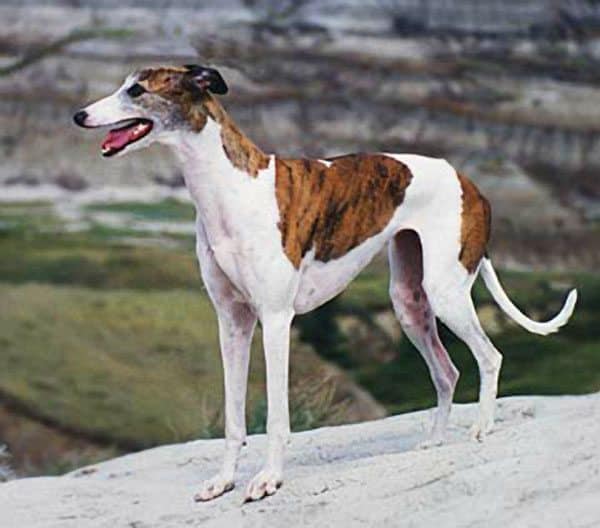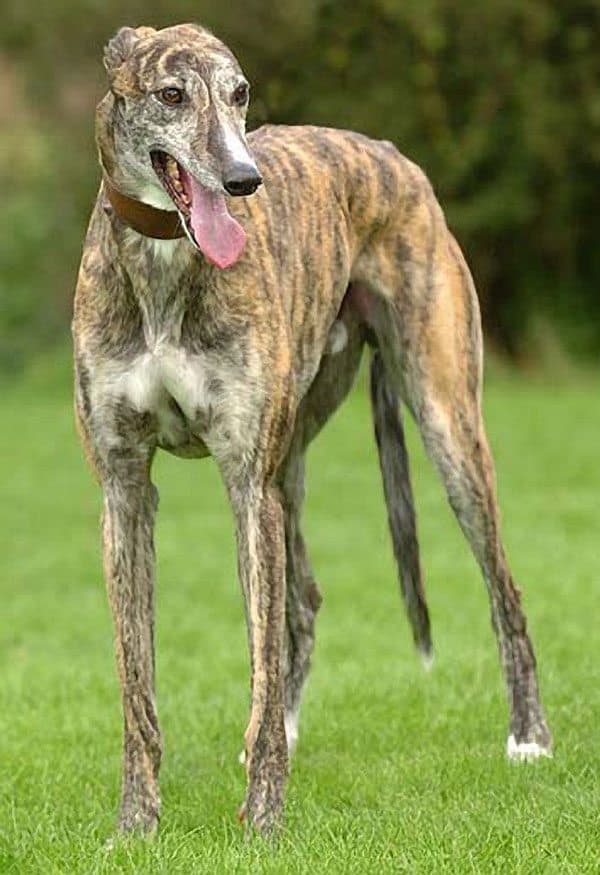
Slender legs reaching, stretching, consuming the ground, then, almost quicker than the eye could see, gathering and stretching again, the Greyhound streaked past, lost in the sheer joy of physical exertion. Around and around the yard he went until his need was satisfied, then he slowed and explored his surroundings, ever alert for a foolhardy rabbit that may try its luck against his speed.
A Greyhound in full stride, muscles straining against thin skin, attention focused on a prey animal or on the internal itch to run, is a creature of rare beauty. In sharp contrast to this insatiable drive to hunt and to run, a Greyhound in the home is a pet of uncommon sweetness and gentility.
Among the most ancient breeds, the Greyhound can be seen in Egyptian tomb carvings dated back to 2751 BC. These carvings depict the dogs attacking deer, a prey it was well-adapted to hunt.
Although the Greyhound also appears in various Celtic, British, Irish, and Scottish pictures and literature dating from the 9th Century, its slender build, deep chest, and thin skin suggest a warm climate birth for the breed.
The Greyhound developed as a sight hunter in the arid and semi-arid lands of North Africa and the Middle East, and the Arabs selectively bred him for increased speed. His hunting ability locked in his appeal to the aristocracy, for sport hunting was the province only of the upper classes.
Although the breed name “Greyhound” seems to be a reference to color, its origin is not so simple. Some attribute the name to a derivation of Graius or Grecian. Others trace it to the old British grech or greg, meaning dog and hundr, meaning hunting. Still others prefer the simpler explanation — the original color of the dogs was gray and the name simply means gray dog .
No matter his color or the origin of his name, the Greyhound was definitely an aristocrat in whatever country he resided. Indeed, the English Parliament protected the status of the breed with a law in 1016 that prohibited ownership to “meane persons” and allowed only conditional ownership to “freemen.” The value of a Greyhound exceeded that of a serf, and the punishment for causing death of a Greyhound was equivalent to the punishment for murder.
The Greyhound can hunt hoofed game and wild canids, but his specialty is rabbits. The English sport of coursing — hunting by sight instead of scent — has roots in ancient Greece, and is a sport valued for the contest more than the catching of the prey. The Greek historian Arrian wrote more than 1800 years ago: “For coursers, such at least as are true sportsmen, do not take their dogs out for the sake of catching a hare, but for the contest and sport of coursing, and are glad if the hare meets with an escape.”
The sport of coursing led directly to the spectator sport of Greyhound racing with the invention of the mechanical rabbit in 1912. With the advent of racetracks and gambling on the outcome of the contests, Greyhound ownership passed from the aristocracy to the general populace, and, like other breeds with some lines bred for work and others for the show ring, the breed has diverged into conformation dogs and racing dogs.
Controversy surrounds Greyhound racing. Faced with competition from riverboats and Indian casinos, many Greyhound tracks and kennels have fallen on hard times. Shocking discoveries of mass Greyhound graves and stories about dogs left by the side of the road or abandoned at shelters has led to nationwide condemnation of Greyhound racing and racing advocates, to anti-racing protests, and to the formation of Greyhound rescue groups. The National Greyhound Association — the industry registry and trade association — responded to the need for new homes for retired racers by setting up an adoption program with the American Society for the Prevention of Cruelty to Animals and by raising money from operating tracks to fund the program. In addition, private individuals started rescue programs that now are national in scope. Together, these private rescues and the industry effort place thousands of dogs in new homes each year.
However, although these rescue organizations are necessary as the Greyhound racing industry shrinks, the majority of the racers do not deserve the contempt they often receive. Most Greyhound kennel owners treat their dogs well and try on their own to find good homes for the ones that aren’t fast enough for the track or have reached retirement age. Many rescue groups have recognized this effort and are working with the owners and tracks to save as many dogs as possible.
Thanks to Dog Owner’s Guide for all the info!


I love these dogs , have three.
It must be great watching them run!
It must be great watching them run!